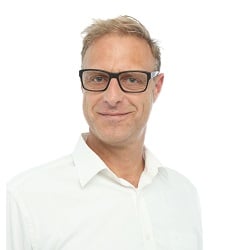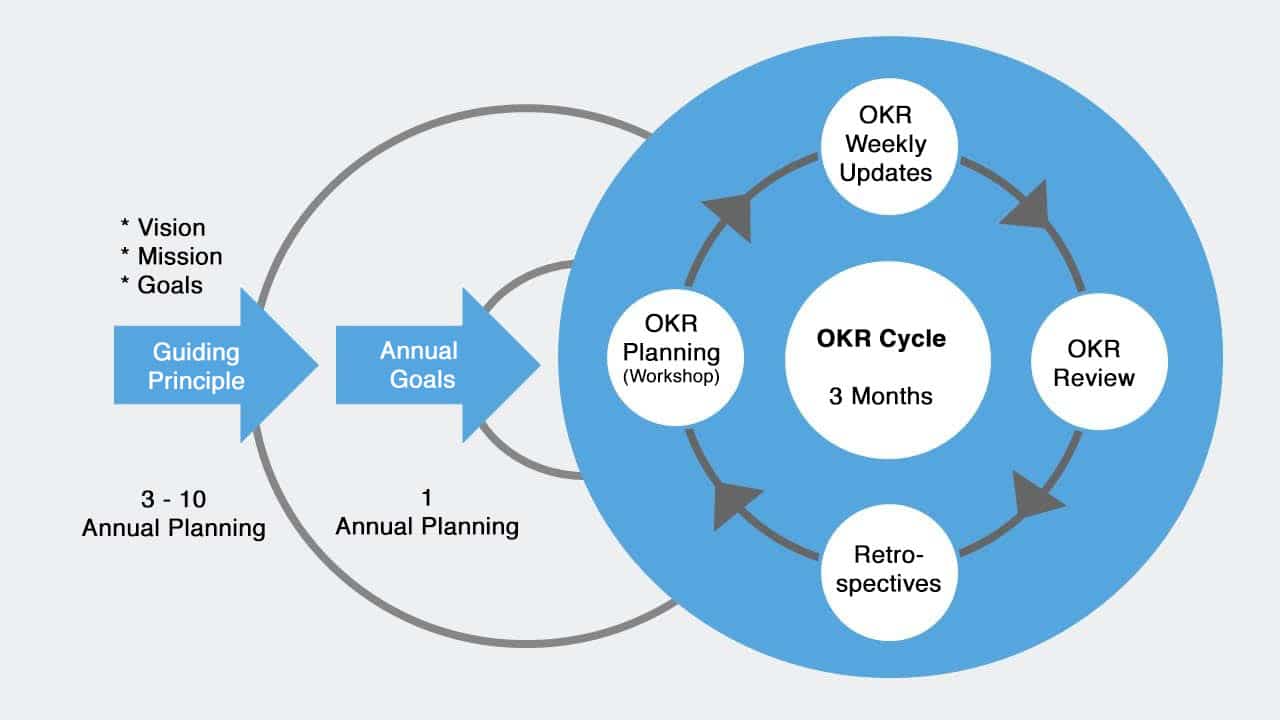Our experiences with Objectives and Key Results (OKR)
I work for such a company: WWM GmbH & CO. KG. WWM is a specialist in the field of trade fair planning and construction and has three main areas of focus:
- Digital Solutions: Provision and realisation of a virtual event portal for digital/virtual and hybrid trade fairs and events. Here, exhibitors are their own independent organisers as part of their content and inbound strategy.
- myWWM: process-controlled physical trade fair presence via online ordering and management portal for planning, execution, control and analysis of live communication measures.
- RocketExpo: project-controlled, individual (hybrid) trade fair construction.
The solution for the described task is: target definition according to the principle of Objectives and Key Results (OKR). In this article, I report on our experiences since the introduction and implementation in 2018.
What is Objectives and Key Results?
Objectives and Key Results (OKR) is a modern method for realising ambitious, measurable goals in a company or organisation.
“OKR is a framework for critical thinking and ongoing discipline that strives to ensure that employees work together, focus and create measurable contributions that move the organisation forward.” (Ben Lamorte)
The framework is formed by Objectives, i.e. the definition of a goal, and Key Results, i.e. a formulation of how this goal is to be measurably achieved. Tasks are the actions that are necessary to achieve the goal.
Here is a schematic example:
- Objective: Assume that the use of large format LED video walls has a great added value for our customers.
- Task 1: We implement the product in our production processes, ensure scalability, supply chain, pricing, etc.
- Task 2: Marketing/Sales: We inform and advise our customers accordingly.
- Key Result: Ten of our customers order exhibition stands in the corresponding OKR cycle, in which these innovative LED video walls are used..
The example shows: an Objective should always be geared to the needs and added value of the customer target group. Therefore, the measurable parameters of the Key Results should always be related to the customer’s reaction.
A prerequisite for successful initiation in a company is a living culture of values and the awareness of a vision and a mission. All three components result in a corporate mission statement. The mission statement of a company is a target agreement for the duration of 3 to 10 years, i.e. for the long term. Another prerequisite is the linking of long-term and short-term goal definitions, namely: Annual goals (or midterm goals=MOALS), which, however, should not be defined too narrowly because the agile focus is on the OKR, i.e. short-term.
- In contrast to conventional “top down” goal setting, OKR corporate goals are developed in the team and realised as a team. In a planning event, the Objectives and Key Results are defined in the team.
- Short weekly update meetings ask about the current measured status and team reactions are discussed briefly if necessary.
- In the review, the OKR and their results are presented by each team.
- The retrospective ensures the continuous improvement of the OKR process, the MOALS and the mission.
- The medium (preferably digital) is the OKR list in which the results are recorded. It is important that the OKR list can be viewed by the team at any time.
- The OKR Master has the responsible role of accompanying, coaching and moderating the process.
Advantages of Objectives and Key Results
The use of Objectives and Key Results offers numerous advantages:
- ensuring a target agreement process, focus, breaking down silo thinking,
- defining who is responsible for the goal achievement process,
- improving internal communication,
- linking of Objectives and Key Results through the whole company,
- defining processes within the team,
- transparency and communication enable higher employee identification with the company (how and why),
- promotion of intrinsic motivation,
- acceleration of internal processes,
- agility through high reaction speed,
- promotion of personal responsibility within the company,
- early warning system for important innovations to be introduced.
Challenges in the application of OKR
Of course, there are some challenges to overcome when applying Objectives and Key Results:
- the company’s management must stand behind the OKR process,
- Objectives and Key Results must not have a control function,
- employees must be trained in detail, preferably by an external consultant,
- the additional time required at the beginning and in the introduction phase must not be underestimated,
- too many goals can be too much of a challenge,
- without a mission statement developed internally by the team, it is pointless,
- there must be an open and agile corporate culture that supports the desire for change.
How did we introduce OKR in the company?
As already mentioned, the prerequisite for the introduction of OKR is a clear idea of the values, visions and missions – i.e. the mission statement.
WWM develops and updates the mission statement at regular intervals. During the revision process in 2018, we noticed that our three units have very different corporate goals. In our opinion, there can be several mission statements in a company, depending on the definition of the goals of the respective department. In several meetings, we laid the foundation for a common, comprehensible goal and created a basis for making sense of what we do together. Everyone in the company knows why they do what they do.
- In the first stage of the introduction, the department heads read up on the subject autodidactically. We defined two books as a basis for this: “OKR” by John Doerr¹ and “OKR – The Ultimate Compendium” by Patrick Lobacher².
- With this preparation, the divisional leadership went into a two-day training led by an OKR coach. So we created our first OKR cycle with the help of professional guidance, which I definitely recommend. We had decided that the board would deal with the issue first, as a vanguard, so to speak. So we minimised the risk, first “practised on the board”, recognised sources of error and also adapted some processes individually to our needs. Agile thinking and acting is a development process, and there is simply a risk that all employees will not follow this path.
- The next step was for each department head to train their team. It is important to remember that the introduction of agile initially means additional work. You have to wait for the success, which of course comes with a time lag. When our customers were enthusiastic after our first joint OKR session, which focused on the optimisation of project planning processes, and the project management also noticed improvements in the timing of the processes, a positive “jolt” went through the team. Objectives and Key Results will never work if the team does not identify with the challenge. In the meantime, each department works out its OKR in the quarterly cycle independently and as a matter of course.
What added value did OKR bring us?
One important learning was that OKR always focuses on the success of the client. The formulation of measurable Key Results was not easy to define in the initial phase. Especially the measurability of the Key Results posed a challenge: it is different whether one defines as a goal for the digitalisation of trade fair stands: “We advise our customers and generate 20 offers with LED video walls”, or “We advise our customers and generate 10 orders in which LED video walls are used”. The latter definition describes a clear positioning of the customer to the product, namely the order.
As all goals relate to the measurable success value of our customers, we launched surveys, and actively sought to understand our customers even better. Through this engagement, the relationship with our customers became even stronger and our customers became even more our fans. Meanwhile, we can derive many referrals from our OKR activities. Thus, the goal-setting method with Objectives and Key Results has also measurably and demonstrably added value to our business.
The awareness and understanding of our employees have improved very positively. A strong intrinsic motivation can be recognised. The “why” has been sharpened and cohesion has been strengthened through teamwork.
We are agile. This was particularly evident in the Corona crisis: within 3 months we created a completely new product that our customers urgently needed to compensate for the trade fair cancellations: The Digital Solutions division now organises virtual events with a turnover in the 7-digit range.
We believe that the trade fair stand future is hybrid. One of our OKRs for Q2 2021 has the Key Result “we sell 4 hybrid exhibition stands”; we have already booked 2 orders. This motivates us and we are working hard to realise more contracts.
Conclusion
Our conclusion is very positive:
- Value culture, vision, mission = mission statement: without a mission statement, the introduction of Objectives and Key Results is pointless.
- OKRs should always be aligned and formulated with the added value for the customer.
- Objectives and Key Results should be objectively measurable in relation to a period of time.
- The entire company should be carefully introduced to the topic so that the sense of purpose and the “why” is lived in the entire team.
And last but not least: OKR can not only improve customer satisfaction, but also the motivation and identification of the employees within the company.
Notes (in German):
[1] John Doerr: OKR
[2] Patrick Lohbacher: OKR – Das umfassende Kompendium

Bernhard Freiter
Bernhard Freiter is Division Manager of the RocketExpo business unit at WWM GmbH & CO. KG. In addition to supporting his team, his focus is on full-service support for new business customers. Hybrid and virtual trade fair concepts, modular and individual construction, measurability and data transparency are important attributes of the RocketExpo mission.
